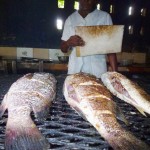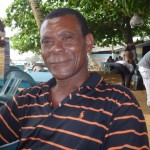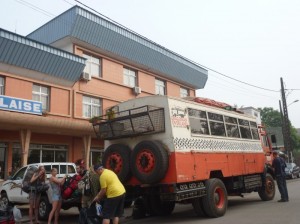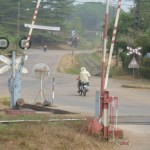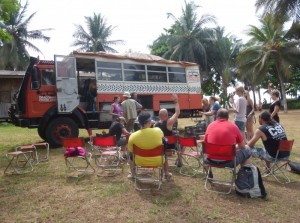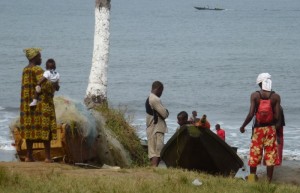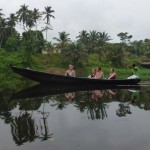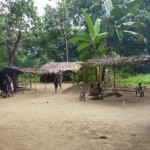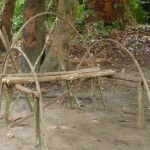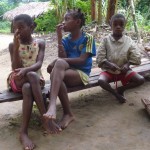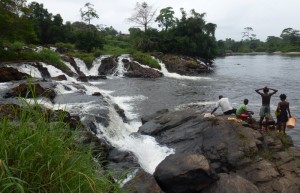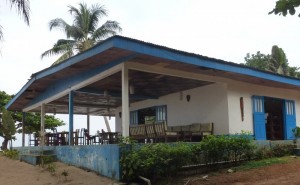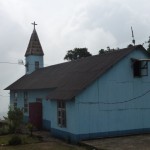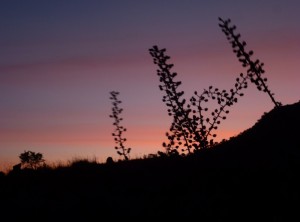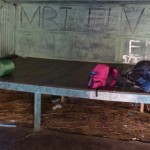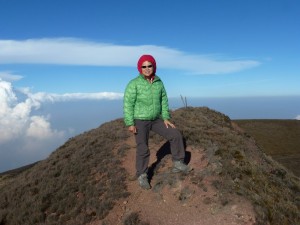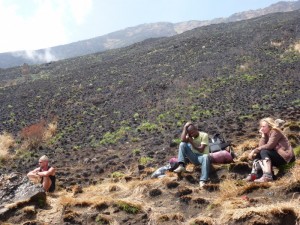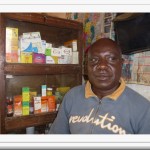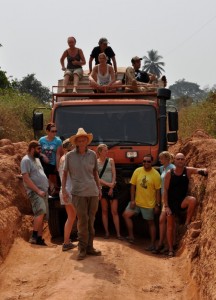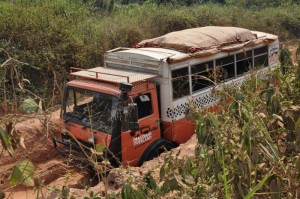 My epic 69-day overland truck journey ‘and journey ‘Doula to Dakar’ with Intrepid began when I arrived at Doula airport at 3am on January 5.
My epic 69-day overland truck journey ‘and journey ‘Doula to Dakar’ with Intrepid began when I arrived at Doula airport at 3am on January 5.
I relaxed on the beach at Kribi for two days and spent two days in climbing Mt Cameroon (4095m), the highest peak in West Africa. The remaining time wasmostly spent on the road. I covered some 1000km before entering Nigeria at the crossing at Ekok.
Background
Cameroon is known as “Africa in miniature” for its geological and cultural diversity. With a total area of 475,000 square kilometres and a population of 16 million, Cameroon has been described as the most dramatic and diverse country in West Africa. The landscape is exceptional
as it stretches from the fringes of the Sahara in the north to the borders of Congo and Gabon in the south with equatorial rainforest, tree-scattered savannah, dry grassy plains, and volcanic ranges with crater lakes. The highest mountain in West Africa is Mt Cameroon at 4095m. Dja Faunal Reserve is Cameroon’s only property on the World Heritage list.
Cameroon divided into ten administrative provinces has a complicated mixture of peoples. There are some 280 ethnic-linguistic groups. Pygmies, the earliest inhabitants who live by hunting and gathering, are still found in the south and the southeast forests. There are five large regional-cultural groups namely the western highlanders, the coastal tropical forest peoples, the southern tropical forest people (including the Pygmies), Islamic people of the northern regions and the Kirdi of the northern desert and central highland. Half the population mostly in the rural areas follows traditional belief systems, a third are Christian and the remainder Muslims.
History
Like most of the African countries, Cameroon is a recent political entity without long history or nationhood. The first Bantoid-speaking peoples moved to the southern half of the Cameroon region from the Nigerian plateau by 200-100BC displacing the Pygmies. There has been no golden era or dominant groups.
In 1472, the Portuguese first arrived to explore the Wouri River followed by Dutch, English, French and German traders. The local chiefs rounded up slaves and ivory which were traded for cloth, metal and other European products. Europeans started to settle around 19th century and began a period of de facto German, French and British occupation to protect their commercial interest.
Cameroon was officially placed under French and British mandates in 1922 after World War I. After World War II, the United Nations renewed the French and British mandates and the British sector continued to be ruled from Nigeria. In the struggle for independence, Ahnadou Ahidjo of the Union des Populations Camerounais (UPC) called for unification and independence from France and organised a revolt in the larger towns in 1955. In 1958, Ahidjo founded a new party L’Union Camerounaise and became the prime minister of the Legislative Assembly of Cameroon calling for reunification and total independence. He proclaimed independence on January 1, 1960. In 1961, the southern British Cameroons voted to join the Francophone territory. But it took 12 more years to prevail over the rebels and the United Republic of Cameroon was formed in 1972 with a new constitution. Ahidijo stepped down in 1982 and Paul Biya became the Prime Minister and his party Cameroon People’s Democratic Movement (CPDM) Party has been in power since.
Like most African countries who won their independence in the second half of the 20th century, Cameroon has suffered from political and economic instability, corruption, military rule, tensions amongst ethnic groups, between the Anglophone and the Francophone, between the Muslim north and the Christian. Today, Cameroon though seemingly has been faring relatively better than some of its neighbours, has a bumpy future ahead as a result of the institutional and systemic problems beset with regional, ethnic and religious differences.
The country has fertile soil and abundant natural resources including oil, gas and timber. Doula also functions as the port for Chad and Central African Republic. Despite its natural resources and favourable position, Cameroon’s economic development has been impeded by mismanagement and pervasive corruption. It had a GDP and GDP per capita of about US$22 billion and US$1,100 (2010).
Day 1 (Thursday, January 5, 2011): Casablanca, Morocco – Doula, Cameroon
I had a nice flight from Casablanca to Doula. The flight was not full and for the first time in my life, I had three seats to myself. I lay down and had a pleasant sleep.
I arrived at the airport in Doula around 3am. The airport is basic and the poor immigration officers had to work with very dim lights. I paid CFA5000 (US$1=CFA480) for a taxi which took me to the wrong Hotel Falisie. I had to pay another CFA2000 for a short ride to my hotel. By the time I settled down and could rest, it was 4:30am. I had to pay CFA35000 for a basic room.
At 10am, I met Mike and Anthony (Ant), our guide cum driver from the UK. They are nice and helpful. Of the 15 participants for the 34-day trip from Doula, Cameroon to Accra, Ghana, eight (including myself) would stay on for the next journey from Accra to Dakar. We have ten female and five male members. We had six Australian, two British, an Irish, a Dane, a Dutch, a Swedish, an American and a New Zealander. My tent mate, Dara, is from the States. Some of us did not have visas for Benin. Ant collected our passports and got us a visa in the afternoon.
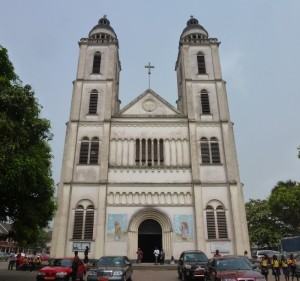 |
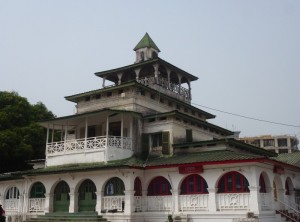 |
Doula with a population of 1.6million is the largest city and commercial centre in Cameroon. Like many African cities, Doula is a sprawling and ugly city. I did not feel like exploring it on foot as I was tired after a sleepless night. I took a taxi for a quick tour of the city for two hours. It only cost me CFA5000. There are some colonial buildings but none is really impressive. My 60-year old French-speaking driver gave me a guided tour before taking me to a local restaurant near the port where I bought a large grilled fish for CFA5000. He told me about his two marriages, six children and four grand-children. He said he is happy with his life though he does not make much money.
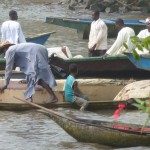 |
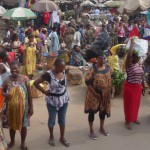 |
Though I was not hungry after my feast, I decided to join the group for dinner at Foyer de Marin which is lovely and cool with plenty of people. It was nice to get to know them since we would be travelling for a month.
Day 2: Doula – Kribi (170km; driving 4 hrs)
We set off for the South Province around 9:30am. We soon arrived in Kribi, a pretty and sleepy beach resort for most Cameroon, her expats and Francophones. We learnt the routine of our new life quickly: we have to cook and set up our own tent and each member has an assigned task. I was responsible for cleaning the truck (which is a difficult task owing to the dusty roads).
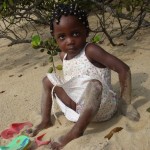 It was a hot day and we all went for a dip in the ocean after a sandwich lunch. I walked along the beach for over a kilometer before meeting a local woman resting in the shade with a baby and a young girl. She told me she had four children (three boys aged 16, 10 and one-month and a girl of 3 years old). Her husband who logs timber, only came home once a month. She was suffering from immense pain after giving birth to her baby. I notice her daughter has deformed legs. She walked to the beach hoping to buy cheap fish but all the fish had gone. She had to spend around CFA5000 on food for her family and life was hard for poor people. I helped her carry her baby to the village which is over 2km away! She invited me to visit her house which is barren but quite spacious.
It was a hot day and we all went for a dip in the ocean after a sandwich lunch. I walked along the beach for over a kilometer before meeting a local woman resting in the shade with a baby and a young girl. She told me she had four children (three boys aged 16, 10 and one-month and a girl of 3 years old). Her husband who logs timber, only came home once a month. She was suffering from immense pain after giving birth to her baby. I notice her daughter has deformed legs. She walked to the beach hoping to buy cheap fish but all the fish had gone. She had to spend around CFA5000 on food for her family and life was hard for poor people. I helped her carry her baby to the village which is over 2km away! She invited me to visit her house which is barren but quite spacious.
We dived in our new camp life without problem. Mike prepared the first dinner with sausages and potatoes and arranged us into five cook teams. Each team takes turn to prepare 3 meals (lunch, dinner and breakfast) for the group. The budget for food per person per day is about US$4 and the group decides the menu and shops in the local market.
Day 3: Kribi
I was assigned to the second cook group with Jens and Naomi. We together with Group 1 went to the market in the morning. Our taxi driver took us to the spot where fish men bring their catch of the day in their boats and locals come to buy the fish. It is atmospheric. We paid only CFA10000 for four fresh fish! I also got a few smaller fish for CFA2000 as gift for the family I visited the day before. Her children were delighted to see me with the fish and kept calling me Auntie Sarah. Her neighbours came to greet me as well! I was glad that my gift was appreciated and would provide a good meal for the family.
I had a leisure afternoon doing nothing. I downloaded my photos to my computer and watched sunset sipping my cold beer.
Day 5: Kribi–Doula – Limbe (250km: driving: 6hrs)
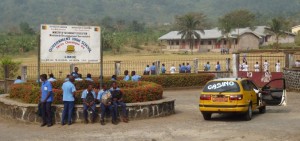 Limbe created by the London Baptist Missionary Society in mid 1850s, is a small, scenic and restful town by the sea with Mt Cameroon looming to the north. It has a port, plantations, palm trees and many lovely beaches with black sand. One finds many well-preserved German and British colonial buildings, a botanic garden and the Limbe Wildlife Centre with drill monkeys.
Limbe created by the London Baptist Missionary Society in mid 1850s, is a small, scenic and restful town by the sea with Mt Cameroon looming to the north. It has a port, plantations, palm trees and many lovely beaches with black sand. One finds many well-preserved German and British colonial buildings, a botanic garden and the Limbe Wildlife Centre with drill monkeys.
We made a brief market stop in order to get provisions for the next few days. We arrived at the Seme Beach Resort with a private black sand beach in the late afternoon. Unfortunately, the camp site is next to a sewage plant with a horrible odor! The air was stuffy and there was thunder and lightning in the middle of the night. We all rushed out to put covers on our tent. It was hot and I slept badly.
Days 6 – 7: Cameroon trek (15km one way)
Barb, Angelito and I decided to undertake an overnight trek to Mt Cameroon which cost us CFA46000 each. A few members preferred to make a day trip. We all set off after 8am for Buea located on the slope of the mountain. We met our guide and two porters and bought some bread and chocolate for the trip at Buea.
We followed the shortest but steepest Guinness Route (around 15km to the summit) and started the ascent around 10:30am going through villages with fields under cultivation with beans, tomatoes, papayas etc. Then we reached the rainforests. It was quite a long walk and we reached Hut 1 (1875m) around 12:30pm. Angelito decided to call it a day as he did not think he’s fit enough to make to the summit. Rick who had originally intended to make a day trip decided to take his place. So Barb, Rick and I set off to Hut 2 (2860m) after lunch. The scenery is not exceptional especially after a recent hill fire. The hill side filled with charcoal made our ascent even tougher. It was hot and I reached the hut just before 5pm. Not too bad as I had not been walking for some three months.
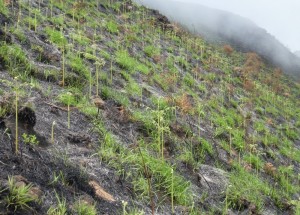 |
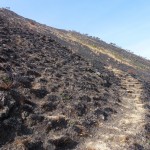 |
The mountain hut is the dirtiest and most horrible place I have even spent a night! Under the planked bed, there is heaps of rubbish. The place is infested with rodents. They run over our feet, up and down the side walls and under the bed! We had to hang our food and bags up. They made so much squealing noises that all three of us could hardly sleep. I am scared that these rodents are disease-infested.
Barb, Rick and I barely had anything for dinner before going to bed at 7:45pm. Though I had my warm sleeping bed and felt clean in my own bedding, I could not sleep at all. I was glad to get up at 3am to prepare for the ascent.
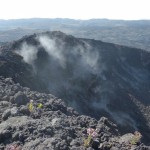 |
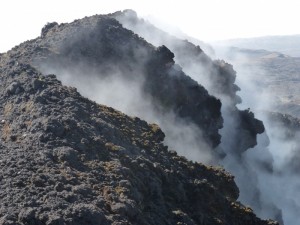 At the beginning, I worried that I might be struck down by altitude sickness. Things turned out better. The path was flooded with moonlight and there was no wind. Hence I was not cold and walked with ease. Though it was a tough and long walk, I saw a nice sunrise around 6am, completed the 8-km trek and reached the summit around 8am. Rick reached the summit an hour earlier while Barb who did not feel well had given up and returned to the hut. The guide took me to see the crater which still has smoke coming out on the way back. The last eruption took place in 2000. The downhill hike was killing me as my toes were bruised. Half way down, I had to put on my slippers –the first time ever I trekked in my slippers! I fell over 30 times. Thank God- I had not hurt myself! I got back to Seme Beach Resort at 5pm.
At the beginning, I worried that I might be struck down by altitude sickness. Things turned out better. The path was flooded with moonlight and there was no wind. Hence I was not cold and walked with ease. Though it was a tough and long walk, I saw a nice sunrise around 6am, completed the 8-km trek and reached the summit around 8am. Rick reached the summit an hour earlier while Barb who did not feel well had given up and returned to the hut. The guide took me to see the crater which still has smoke coming out on the way back. The last eruption took place in 2000. The downhill hike was killing me as my toes were bruised. Half way down, I had to put on my slippers –the first time ever I trekked in my slippers! I fell over 30 times. Thank God- I had not hurt myself! I got back to Seme Beach Resort at 5pm.
To award myself for the strenuous hike, I got myself a room at the hotel so that I could sleep well and washed all the dirt and black charcoal away. The hotel was nice and gave me a room for CFA20000 (about US$40).
Day 8: Limbe –Kumba –jungle (240km: 6hrs)
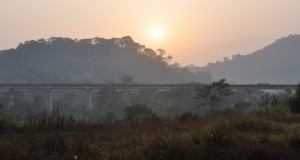 We started to head north towards the Nigeria border and had a stop in Kumba for shopping. Naomi, Jen and I got some vegetables, pasta and canned food and then had a delicious lunch in a street stall. A grilled mackerel served with hot chili sauce only cost CFA700. I love fish and found it most delicious. I had a cold local beer for CFA500. I was pleased with my meal and wished I could have more time to roam on my own and to taste local food.
We started to head north towards the Nigeria border and had a stop in Kumba for shopping. Naomi, Jen and I got some vegetables, pasta and canned food and then had a delicious lunch in a street stall. A grilled mackerel served with hot chili sauce only cost CFA700. I love fish and found it most delicious. I had a cold local beer for CFA500. I was pleased with my meal and wished I could have more time to roam on my own and to taste local food.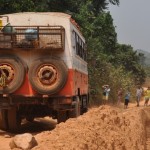
Once we got out of Kumba, we started our bumpy ride on the red piste i.e. a dirt road. Vegetation on both sides of the road turns red as a result of the red soil. Our truck drove through a couple enormous pot holes which are 1.5-metres deep! We had our first bush camping by a river and I bathed in the clear stream. Cool!
Day 9: Jungle – Mamfe- jungle (150km; 6hrs)
We spent the whole day on the dirt road with only a brief stop at Mamfe. I found myself covered in dirt and dust! The Chinese are helping the government to construct a major highway to Bamenda with some of the forests being cleared for its construction. Will this highway bring economic benefits to the region? Will it be an environmental disaster? I wonder.
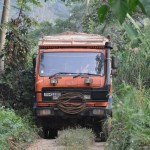 |
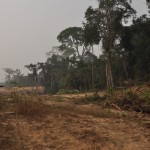 |
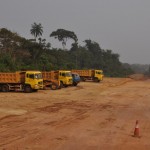 |
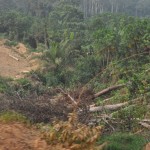 |
We camped at a construction site next to the highway. Pretty awful but that is the nature of this overland adventure!
Day 10 (January 14): Jungle –Ekok border crossing –Ikom, Nigeria–Afi mountain (140km; 6 hrs)
We were only 50km from the border. The road turned out to be better than expected and we took only two hours to reach Ekok, the border town on the Cameroon side. My right leg was badly bitten since I left Limbe. My skin was itchy, red and swollen. I was desperate and found a pharmacy where there was a local doctor who has some training by the Red Cross. He looked confident and assuring. He said the bites were not too serious and gave me some cream to put on and two types of pills to take. I paid a total of CFA4000. (It worked and the itches went away the next day so that I could have a good sleep).
Remarks
It’s my first truck journey of a participatory nature. We spend less than US$5 per head on food and bush camp twice. I have never been so frugal in my life! But life can be very simple and we can eat well on a couple of dollars a day in Africa as millions of Africans are living on less than a dollar a day. Quite an experience!
To my surprise, the dirt road through the jungles in Cameroon is not as bad as I had imagined (perhaps I have been sanitised after my travel in Ethiopia and Uganda).The road condition is generally better during the dry season and it may be totally different during the wet season. I did not have back pain despite the long hours on bumpy roads.
According to the original itinerary, the group would spend eight instead of ten days in Cameroon. The country is green and pleasant and the people are friendly. I find the houses along the road built in wooden planks, clay-mud or bricks though small are generally well-kept. We covered about 1000km passing through countless roadblocks in four provinces in the south and southwestern parts of the country.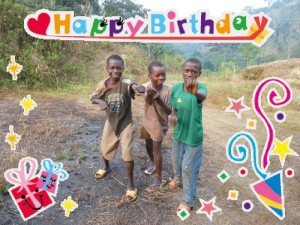
I am glad to do shopping in the local markets, hold simple conversations in French with drivers and the woman on the Kribi beach and to visit her house. Nonetheless, I still do not have a sense about the place and the people. What is missing? In a nutshell, I need more time to explore the place, meet the people and sample the local food before I can discover the real Cameroon and its distinctive characters.
I had no plan to climb Mt Cameroon but was glad to reach the summit. Mt Cameroon is not yet designated as a national park and there is hardly any planning and management at all. The landscape and scenery are not as impressive as those in Mt Kenya, Mt Meru and other national parks in Ethiopia and Namibia which I have visited. Tourism can be an important revenue earner and there will be growing interest in Africa as a destination. West Africa has been off the beaten track and has potential. I hope the government will accord priority to develop and manage its tourism resources.


